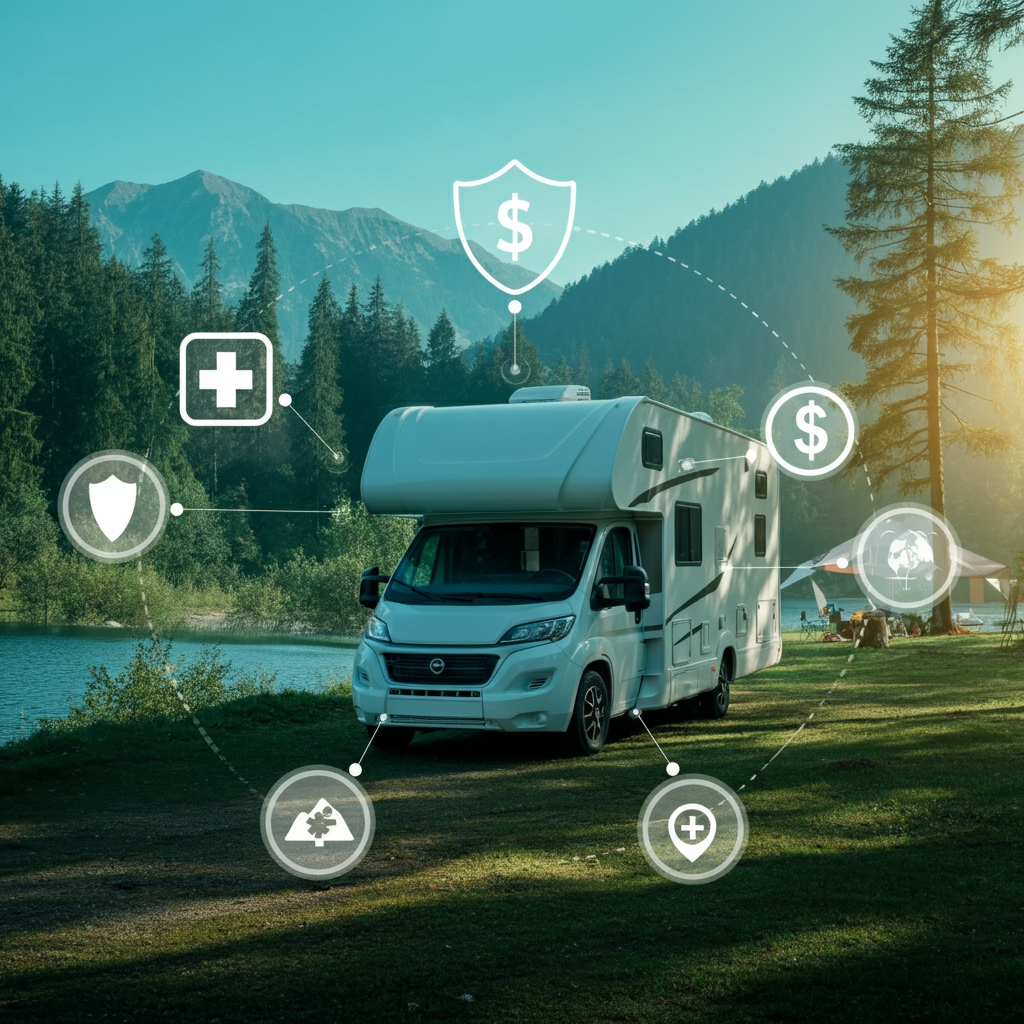Owning a recreational vehicle (RV) opens up a world of adventure, offering the freedom to travel, explore, and camp wherever the road takes you. However, with this freedom comes significant responsibility—chief among them being protecting your investment with RV insurance. Accidents, weather damage, theft, and liability risks are just some of the uncertainties RV owners may encounter. RV insurance ensures that you’re covered, whether your motorhome, camper, or trailer is stationary or on the move.
This guide will break down everything you need to know about RV insurance, from its types and benefits to premium factors, policy selection, and money-saving tips.
What Is RV Insurance and Why Is It Important?
RV insurance is designed specifically to protect recreational vehicles. It combines elements of auto, home, and travel insurance into a tailor-made policy that covers the unique risks associated with RV ownership. Whether you use your RV full-time, part-time, or just for short getaways, RV insurance offers financial protection and peace of mind.
Why Is RV Insurance Important?
- Legal Compliance
If your RV is motorized (like a Class A motorhome), state laws typically require you to carry liability insurance, just like a car. Even for towable RVs, many campgrounds and private parks mandate proof of insurance for liability purposes.
- Protects Your Investment
RVs represent a significant financial commitment. Comprehensive and collision coverage ensure you’re not left paying hefty repair or replacement costs after accidents or disasters.
- Covers Liability Risks
Whether you accidentally crash into another vehicle or someone injures themselves in or around your RV, liability coverage protects you from costly legal and medical expenses.
- Tailored to RV-Specific Risks
Unlike standard auto insurance, RV insurance addresses unique risks like personal belongings stored in your RV, vacation-related liability, and damage caused by events such as hailstorms or wildlife interactions.
- Peace of Mind
Life on the road comes with many uncertainties. Knowing that your RV and personal financial security are safeguarded allows you to focus on enjoying your journeys.
Types of RV Insurance Coverage
There are several types of coverage available, ensuring you can customize your RV insurance policy to fit your particular needs. These coverage types address everything from accidents to personal belongings and unique vacation-related risks.
1. Liability Insurance
Liability insurance is required in most states for motorized RVs and covers damages or injuries you cause to other people or their property.
What It Covers:
- Bodily Injury Liability: Covers medical expenses, legal fees, and income loss for injured parties.
- Property Damage Liability: Covers repair costs for vehicles or property damaged in an accident you caused.
Best For:
This foundational coverage is essential for all RV owners, especially those driving motorized RVs like Class A, B, or C motorhomes.
2. Collision Insurance
Collision insurance pays for damages to your RV following an accident, regardless of who’s at fault.
What It Covers:
- Repairs or replacement costs for your RV if it’s damaged in a collision with another vehicle or object.
Best For:
Owners of newer or high-value RVs, as repair costs can be substantial for larger vehicles.
3. Comprehensive Insurance
Comprehensive insurance covers non-collision-related damage to your RV, addressing risks beyond accidents.
What It Covers:
- Theft or vandalism.
- Fire or smoke damage.
- Weather-related events like hail, floods, or windstorms.
- Animal-related damages, such as when hitting wildlife.
Best For:
All RV owners, especially those in high-risk areas prone to bad weather or theft.
4. Uninsured/Underinsured Motorist Coverage
This coverage protects you and your RV when involved in an accident with an uninsured or underinsured driver.
What It Covers:
- Medical expenses.
- Repairs or replacement for your RV.
Best For:
Drivers in states with high rates of uninsured motorists or those who frequently travel through areas with such risks.
5. Personal Belongings Coverage
RVs double as living spaces, often filled with valuables such as electronics, clothing, kitchenware, and camping gear. Personal belongings coverage steps in if items inside your RV are stolen or damaged.
What It Covers:
- Replacement costs for personal belongings stored in your RV.
Best For:
Full-time RVers or those who travel with high-value personal belongings.
6. Vacation Liability Insurance
Vacation liability insurance provides additional protection when your parked RV serves as your vacation residence.
What It Covers:
- Medical or legal costs if someone is injured inside or around your stationary RV.
Best For:
Part-time travelers who park their RVs at campgrounds or RV parks frequently.
Factors That Influence RV Insurance Premiums
Several variables impact how much you’ll pay for RV insurance. Understanding these factors can help you manage your costs and tailor your policy effectively.
1. Type of RV
- Motorized RVs (Class A, B, C): These vehicles often have higher premiums because they combine vehicle and dwelling responsibilities.
- Towable RVs (Fifth Wheels, Travel Trailers): Generally less expensive to insure, though liability insurance may still be required.
2. Usage
- Full-Time RVers: Premiums are higher due to increased risks since the RV serves as both a home and vehicle.
- Occasional Use: Part-time travelers benefit from lower premiums thanks to reduced use and wear.
3. Location
- Rural areas may have lower rates, while urban regions or areas with high crime rates could see higher premiums.
- Risks from natural disasters like hurricanes or wildfires also influence costs.
4. Driving and Claims History
- A clean driving record leads to lower premiums, while accidents, tickets, or a history of claims will increase costs.
5. Coverage Limits and Deductibles
- Higher coverage limits raise premiums but provide more extensive protection.
- Opting for a higher deductible lowers monthly costs but increases out-of-pocket expenses in the event of a claim.
Tips for Choosing the Right RV Insurance Policy
Finding the right RV insurance requires balancing coverage needs with budget considerations. Here’s how to select the most appropriate policy for your situation:
1. Evaluate Your Unique Needs
Consider the following:
- RV type and value—Is it motorized or towable? Old or new?
- Your travel habits—Are you full-time or a seasonal traveler?
- Personal Assets—Do you travel with high-value belongings?
2. Research Insurers
Look for RV insurance specialists or companies with positive reviews for claims processing. Compare quotes to find the best balance of cost and coverage.
3. Understand the Terms
Ensure you’re familiar with what’s covered, excluded, and required. Pay close attention to deductibles, limits, and any add-ons.
4. Ask About Unique Policy Features
Request add-ons like roadside assistance, emergency expense coverage for trip interruptions, or pet injury coverage if needed.
Strategies for Saving Money on RV Insurance
RV insurance doesn’t have to be expensive. Here are several ways to lower premiums while maintaining solid coverage:
1. Bundle Policies
Many insurers offer discounts when you bundle RV insurance with auto, home, or other policies.
2. Take Advantage of Discounts
Insurers often provide discounts for:
- Safe driving records.
- RV safety features (e.g., anti-theft devices).
- Completing RV safety training courses.
- Seasonal or storage periods during which the RV isn’t used.
3. Increase Your Deductible
Opting for a higher deductible reduces your monthly premiums. However, ensure you can afford the deductible in case of an accident.
4. Limit Optional Coverages
Evaluate your RV’s current value and consider eliminating unnecessary coverages for older models.
5. Shop Around
Get quotes from multiple providers to find the best deal. Even small differences in rates can save you hundreds annually.
Final Thoughts
RV insurance is essential for safeguarding your vehicle, belongings, and financial security. From liability protection to covering your personal belongings, the right policy will ensure that you can travel with confidence, no matter where the road leads.
Start by assessing your travel habits, risks, and assets, and use this information to customize a policy that fits your needs and budget. Don’t forget to take advantage of bundles, discounts, and other cost-saving strategies to maximize value. With adequate coverage in place, you can focus on what matters most—enjoying life’s great adventures in your RV.




